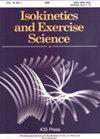动态和弹道拉伸对对侧下肢柔韧性的不同影响
IF 0.6
4区 医学
Q4 ENGINEERING, BIOMEDICAL
引用次数: 0
摘要
背景:动态拉伸(DS)和弹道拉伸(BS)是类似的拉伸方法,但它们之间的区别尚不清楚。目的:探讨单侧腘绳肌DS和BS对双侧肢体直腿抬高(SLR)、膝关节屈曲活动范围(KF- rom)、KF和膝关节伸展最大等速峰值扭矩(KF- mipt和KE-MIPT)的直接影响。方法:12名健康成年男性进行4组右下肢非拉伸、DS或BS,每组2分钟。干预前后分别测量双侧SLR、KF-ROM、KF-MIPT和KE-MIPT;采用三向(干预×肢体×时间)重复测量方差分析(ANOVA)。结果:DS组伸展肢体的SLR高于干预前(p< 0.01)。伸展肢体的SLR (p< 0.01)和KF-ROM (p< 0.05),对侧肢体的SLR (p< 0.05)和KF-ROM (p< 0.05)均高于干预前。KF-MIPT与KE-MIPT之间无显著主效应或相互作用。结论:DS和BS对ROM的影响略有不同,均不影响肌力;因此,在热身期间结合这些技术可能会有所帮助。本文章由计算机程序翻译,如有差异,请以英文原文为准。
Differential effects of dynamic and ballistic stretching on contralateral lower limb flexibility
BACKGROUND: Dynamic stretching (DS) and ballistic stretching (BS) are similar stretching methods, but the differences between them are unclear. OBJECTIVE: To examine the immediate effects of unilateral hamstring DS and BS on straight leg raise (SLR), knee flexion range of motion (KF-ROM), and KF and knee extension maximal isokinetic peak torque (KF-MIPT and KE-MIPT) of the bilateral limbs. METHODS: Twelve healthy adult men performed four sets of 2 min each of non-stretching, DS, or BS of the right lower extremity. Bilateral SLR, KF-ROM, KF-MIPT, and KE-MIPT were measured pre- and post-intervention; a three-way (intervention × limb × time) repeated-measures analysis of variance (ANOVA) was used. RESULTS: The SLR of the stretched limb (p< 0.01) was higher with DS than that pre-intervention. SLR (p< 0.01) and KF-ROM (p< 0.05) of the stretched limb and SLR (p< 0.05) and KF-ROM (p< 0.05) of the contralateral limb were higher with BS than those pre-intervention. There was no significant main effect or interaction between KF-MIPT and KE-MIPT. CONCLUSION: DS and BS had slightly different effects on ROM, and neither affected muscle strength; thus, combining the techniques during warm-up might be helpful.
求助全文
通过发布文献求助,成功后即可免费获取论文全文。
去求助
来源期刊

Isokinetics and Exercise Science
医学-工程:生物医学
CiteScore
1.20
自引率
14.30%
发文量
37
审稿时长
>12 weeks
期刊介绍:
Isokinetics and Exercise Science (IES) is an international journal devoted to the study of theoretical and applied aspects of human muscle performance. Since isokinetic dynamometry constitutes the major tool in this area, the journal takes a particular interest in exploring the considerable potential of this technology.
IES publishes studies associated with the methodology of muscle performance especially with respect to the issues of reproducibility and validity of testing, description of normal and pathological mechanical parameters which are derivable from muscle testing, applications in basic research topics such as motor learning paradigms and electromyography. The journal also publishes studies on applications in clinical settings and technical aspects of the various measurement systems employed in human muscle performance research.
The journal welcomes submissions in the form of research papers, reviews, case studies and technical reports from professionals in the fields of sports medicine, orthopaedic and neurological rehabilitation and exercise physiology.
 求助内容:
求助内容: 应助结果提醒方式:
应助结果提醒方式:


